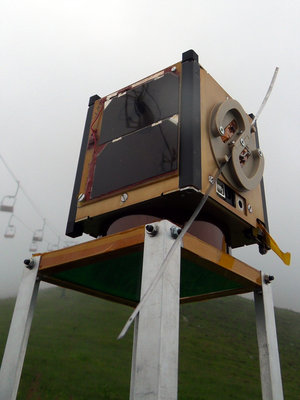Meet the teams: Masat-1
Seven teams of university students were selected to fly their CubeSats on the maiden flight of ESA's Vega launch vehicle. Here is an introduction to the Hungarian team.
| University | Budapest University of Technology and Economics, Faculty of Electrical Engineering and Informatics, Hungary |
| Endorsing professor | András Gschwindt |
| Team | Gyula Horváth, Csaba Szombathy, Zoltán Kovács, Gábor Marosy, András Bükkfejes, Dávid Czifra, Levente Dudás, Sándor Glisics, Emil Hödl, Balázs Knipfer, Tibor Mezei, András Szimler, Tamás Temesvölgyi, János Vancsik, Lajos Varga, Zsolt Várhegyi |

The Masat-1 team is composed of 14 students from the Faculty of Electrical Engineering and Informatics in the Budapest University of Technology and Economics. Some of them have previously worked together on other space-related projects, such as ESA's European Student Earth Orbiter (ESEO) satellite, but none of them had any experience of CubeSats.
Since Masat-1 is the first satellite ever to be designed and built in Hungary, the team regard it as a technology demonstration project which can be used as a prototype of a future satellite bus.
The Masat-1 project began in September 2007, when some of the students attended the First Polish-Hungarian Space Conference, held in Budapest. There they met members of the PW-Sat team, who shared their excitement about their own CubeSat project, which was then still in its early phase of development.
This meeting sparked the interest of the Budapest university students, and a few days after the conference, Gábor Marosy, one of the team’s leading system engineers, knocked on the door of Gyula Horváth, now the Masat-1 project manager, and asked him: "How about building a CubeSat?" Four years later, their initiative is about to be rewarded.
The two objectives of the Masat-1 project are:
- To design and implement the basic subsystems of a custom-built satellite.
- To gain experience in the leadership, logistics, testing and launch of a complex space project, in preparation for future, more advanced programmes.
Since the satellite is entirely custom-designed and built, the team has always considered every onboard subsystem to be an experiment. For example, the 6 channel photovoltaic energy conversion system provides a redundant energy source for the satellite. The data logging scheduler employs adaptive compression capability. The Attitude Determination and Control System is a hybrid solution based on a permanent magnet, while damping is achieved both with electromagnetic coils and hysteresis dampers.
In order to monitor the performance of the innovative satellite, every subsystem is carefully monitored. The key parameters of interest, such as voltages, currents, temperatures and attitude of the satellite, are recorded on board Masat-1 and sent back via more than 200 telemetry channels.
The CubeSat experience

How did the team members deal with the experience of CubeSat selection, design, construction, testing and integration?
"We tried to keep an attitude of professionalism through the whole working process; however this did not prevent us from some healthy failures, as we were audacious enough to design and build a fully customised satellite from scratch. We have learned a lot in the process, and not only in the technical sense."
With the period of development now at an end, the team is now looking forward to a new phase in their space education as they operate their country’s first satellite and receive the flow of scientific data and telemetry.
"We believe that we have built a satellite versatile enough to enable creative ways of operation and post-processing the downloaded data. We also have possible future projects in mind, when we expect to reach a substantially broader circle of students during the operational phase."






